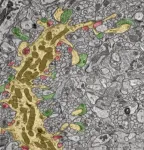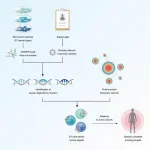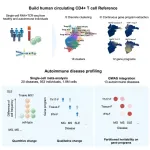(Press-News.org) A new study led by researchers from the UCLA Health Jonsson Comprehensive Cancer Center shows that using high doses of radiation while integrating an ablative radiotherapy technique called stereotactic ablative radiotherapy (SABR) concurrently with chemotherapy is safe and effective in treating people with locally advanced non-small cell lung cancer that is not suitable for surgery.
Based on mid-treatment response, researchers found the combination treatment, which involves a second radiation plan to personalize a boost for the last third of radiation treatments, is a viable and promising option that helps reduce the risk of toxic side effects and having the cancer return within the chest.
The findings were published in the journal JAMA Oncology.
“This treatment method explores uncharted territory,” said Dr. Trudy Wu, a radiation oncology resident at UCLA and first author of the study. “Our field has been moving towards hypofractionation across many disease sites; however, it is particularly challenging in locally advanced lung cancer due to the close vicinity of tumor to sensitive structures such as the airways and esophagus. This treatment is also typically delivered with chemotherapy which magnifies treatment-related toxicity. Using a novel adaptive boost technique personalized to an individual’s treatment response after the first two thirds of radiation treatment allows for a tighter conformal radiation boost plan and reduction of healthy tissue receiving radiation.”
In the past, the prognosis for those with unresectable, locally advanced non-small cell lung cancer has been poor, with low survival rates despite treatment with a combination of chemotherapy and radiation. Current standard of care for this group of patients consists of 30 treatments spanning over six weeks, which can be logistically challenging for many patients. While outcomes have improved with the help of modern treatment advances, like immunotherapy, a portion of patients still develop disease relapse in the chest.
One potential way to prevent cancer from returning within the chest after local therapy is to deliver radiation with a higher dose per single treatment in a more intense, or ablative, fashion.
To find the highest personalized boost dose that could be given safely in combination with chemotherapy, 28 patients at UCLA with stage II or III non-small cell lung cancer were enrolled between May 2011 and May 2018 on an early phase dose escalation trial.
All patients first received a base radiation dose of 4 Gy × 10 fractions followed by an adaptive SABR boost to target any remaining metabolically active cancer. The first ten patients received a boost dose of 25 Gy (low, 5 Gy × 5 fractions). If this was deemed safe within a specified follow-up period, patients proceeded to receive a higher boost dose of 30 Gy (intermediate, 6 Gy × 5 fractions), followed by 35 Gy (high, 7 Gy × 5 fractions), all with concurrent weekly chemotherapy.
Along with determining the maximum tolerated dose of this novel and personalized approach, the researchers aimed to improve progression-free survival and shorten the overall duration of treatment for locally advanced non-small cell lung cancer.
The investigators observed the most promising results in the intermediate-dose cohort, where patients received a total of 70 Gy in 15 fractions, inclusive of a 30 Gy boost. This dosage showed a favorable balance between side effects while being a very effective treatment.
Rates of two-year local control, which is when the cancer does not grow back, were 74.1%, 85.7%, and 100.0% for the low-, intermediate-, and high-dose cohorts. Two-year overall survival was 30.0%, 76.2%, and 55.6% for the low-, intermediate-, and high-dose cohorts.
There were no severe toxic effects observed in the intermediate-dose boost cohort. Most patients experienced some degree of mild side effects which included fatigue, and inflammation of the esophagus or lungs resulting in sore throat or cough, respectively. The high dose regimen led to severe treatment-related side effects in two cases.
“Our data shows patients may benefit from targeted, high-dose radiation with chemotherapy if it’s done thoughtfully with adaptive radiation,” said Dr. Beth Neilsen, a study author and radiation oncology resident at UCLA. “For the intermediate dose regimen, the incidence of severe side effects was relatively low and showed potential for better local control of the cancer.”
The authors note this approach could be explored further in future trials with the addition of consolidation immunotherapy, which is now standard of care in this setting.
“This study contributes to ongoing efforts to improve the treatment lung cancer, a leading cause of cancer-related death,” said Dr. Michael Steinberg, professor and chair of radiation oncology at the David Geffen School of Medicine, director of Clinical Affairs at the UCLA Health Jonsson Comprehensive Cancer Center and one of the senior authors on the study. “The integration of adaptive radiation with chemotherapy offers a novel approach that shows promise in terms of safety, effectiveness and improved patient outcomes, paving the way for more effective and personalized treatments.”
The investigators also noted the study has limitations, including a small sample size and need for longer follow-up to assess late side effects.
The study’s senior author is Dr. Percy Lee, who was a professor of radiation oncology at UCLA when the research was conducted and is now a practicing radiation oncologist at City of Hope. Other involved UCLA researchers include Dr. Jonathan Goldman, Dr. Edward Garon, Dr. Jay Lee, Carol Felix, Minsong Cao, Stephen Tenn and Daniel Low.
END
High-dose radiotherapy with chemotherapy effective in treating people with non-small cell lung cancer
UCLA-led study finds delivering high doses of radiation with chemotherapy for locally advanced lung cancer is safe and effective when integrating a novel adaptive boost
2024-01-11
ELSE PRESS RELEASES FROM THIS DATE:
Synapses brought to the point
2024-01-11
Whether picking up a small object like a pen or coordinating different body parts, the cerebellum in the brain performs essential functions for controlling our movement. Researchers at the Institute of Science and Technology Austria (ISTA) investigated how a crucial set of synapses between neurons within it functions and develops. Their findings have now been published in the journal Neuron.
Even if you do not think about it, every day you are using the intricate circuits of neurons in your brain to perform astonishingly delicate movements with your body. One essential unit in this is the cerebellum playing a key role in fine motor control, coordination, and timing.
“Every ...
Catalytic combo converts CO2 to solid carbon nanofibers
2024-01-11
UPTON, NY—Scientists at the U.S. Department of Energy’s (DOE) Brookhaven National Laboratory and Columbia University have developed a way to convert carbon dioxide (CO2), a potent greenhouse gas, into carbon nanofibers, materials with a wide range of unique properties and many potential long-term uses. Their strategy uses tandem electrochemical and thermochemical reactions run at relatively low temperatures and ambient pressure. As the scientists describe in the journal Nature Catalysis, this approach could successfully lock carbon away in a useful solid form to offset or even achieve negative carbon emissions.
“You can put the carbon nanofibers ...
Substance use disorders among adult cancer survivors
2024-01-11
About The Study: The findings of this study of 6,101 adult cancer survivors suggest that substance use disorder (SUD) prevalence is higher among survivors of certain types of cancer; this information could be used to identify cancer survivors who may benefit from integrated cancer and SUD care. Future efforts to understand and address the needs of adult cancer survivors with comorbid SUD should prioritize cancer populations in which SUD prevalence is high.
Authors: Devon K. Check, Ph.D., of the Duke University School of Medicine in Durham, North Carolina, is the corresponding author.
To access the ...
Head and neck cancer incidence before and during the pandemic
2024-01-11
About The Study: In this study of patients diagnosed with head and neck cancer from 2017 to 2020 in the U.S., the incidence of localized head and neck cancer declined during the first year of the pandemic. A subsequent increase in advanced-stage diagnoses may be observed in later years.
Authors: Nosayaba (Nosa) Osazuwa-Peters, B.D.S., Ph.D., M.P.H., C.H.E.S., of the Duke University School of Medicine in Durham, North Carolina, is the corresponding author.
To access the embargoed study: Visit ...
Wellcome Sanger Institute: Cancer drug discovery accelerated as hundreds of overlooked targets prioritised
2024-01-11
A new, systematic analysis of cancer cells identifies 370 candidate priority drug targets across 27 cancer types, including breast, lung and ovarian cancers.
By looking at multiple layers of functional and genomic information, researchers were able to create an unbiased, panoramic view of what enables cancer cells to grow and survive. They identify new opportunities for cancer therapies in a significant leap towards a new generation of smarter, more effective cancer treatments.
In the most comprehensive study of its kind, researchers ...
ChatGPT has read almost the whole internet. That hasn't solved its diversity issues
2024-01-11
AI language models are booming. The current frontrunner is ChatGPT, which can do everything from taking a bar exam, to creating an HR policy, to writing a movie script.
But it and other models still can’t reason like a human. In this Q&A, Dr. Vered Shwartz (she/her), assistant professor in the UBC department of computer science, and masters student Mehar Bhatia (she/her) explain why reasoning could be the next step in AI—and why it’s important to train these models using diverse ...
First direct imaging of small noble gas clusters at room temperature
2024-01-11
For the first time, scientists have succeeded in the stabilisation and direct imaging of small clusters of noble gas atoms at room temperature. This achievement opens up exciting possibilities for fundamental research in condensed matter physics and applications in quantum information technology. The key to this breakthrough, achieved by scientists at the University of Vienna in collaboration with colleagues at the University of Helsinki, was the confinement of noble gas atoms between two layers of graphene. This method overcomes the difficulty that noble gases do not form stable structures under experimental conditions ...
CD4+ T cell patterns linked to autoimmune disorders
2024-01-11
Osaka, Japan – Much like ripples on the water can betray powerful currents below the surface, small changes in our bodies can sometimes be an indicator of a serious condition. Now, researchers from Japan say that cells in the blood may provide telltale signs of important immune dysfunction.
In a study recently published in Cell Genomics, researchers from Osaka University have revealed that subtle changes in specific immune cell populations may signal the presence of an autoimmune disease.
In autoimmune conditions, which affect up to 5% of the population, the body’s immune cells attack the body ...
A tiny tattoo for a tabby
2024-01-11
Tokyo, Japan – If you’ve ever taken a car trip through a rural area, you might already know that livestock, including cows and sheep, can be individually tracked using decidedly old-fashioned methods, such as ear tags or even branding marks. By contrast, many tech-savvy pet owners have opted to have their dog or cat “chipped” by having a radio frequency identification (RFID) permanently implanted under the skin. However, all these identification solutions leave something to be desired, as ear tags can become damaged or lost, while RFID chips require an invasive procedure to insert and specialized equipment to read.
In a study recently published in Scientific ...
JMIR AI has passed the Scientific Quality Review by NLM for PMC
2024-01-11
JMIR Publications is pleased to announce that JMIR AI has passed the Scientific Quality Review by the US National Library of Medicine (NLM) for PubMed Central (PMC). This decision reflects the scientific and editorial quality of the journal. All articles published from 2022 onward will be found on PMC and PubMed after their technical evaluation.
Launched in 2022, JMIR AI is a new journal that focuses on the applications of artificial intelligence in health settings. This includes contemporary developments as well as historical ...
LAST 30 PRESS RELEASES:
$80 million in donations propels UCI MIND toward world-class center focused on dementia
Illinois research uncovers harvest and nutrient strategies to boost bioenergy profits
How did Bronze Age plague spread? A sheep might solve the mystery
Mental health professionals urged to do their own evaluations of AI-based tools
Insufficient sleep associated with decreased life expectancy
Intellicule receives NIH grant to develop biomolecular modeling software
Mount Sinai study finds childhood leukemia aggressiveness depends on timing of genetic mutation
RSS Research Award for new lidar technology for cloud research
Novel AI technique able to distinguish between progressive brain tumours and radiation necrosis, York University study finds
Why are abstinent smokers more sensitive to pain?
Alexander Khalessi, MD, MBA, appointed Chief Innovation Officer
Optical chip pioneers physical-layer public-key encryption with partial coherence
How your brain understands language may be more like AI than we ever imagined
Missed signals: Virginia’s septic strategies overlook critical timing, study warns
Delayed toxicities after CAR T cell therapy for multiple myeloma are connected and potentially preventable
Scientists find cellular key to helping plants survive in saltwater
Medical cannabis program reduces opioid use
Immunotherapy works for sepsis thanks to smart patient selection
Cardiovascular events 1 year after RSV infection in adults
US medical prices and health insurance premiums, 1999-2024
Medical cannabis and opioid receipt among adults with chronic pain
Multichannel 3D-printed bioactive scaffold combined with siRNA delivery for spinal cord injury recovery
Triaptosis—an emerging paradigm in cancer therapeutics
A new paradigm in spectroscopic sensing: The revolutionary leap of SERS-optical waveguide integration and ai-enabled ultra-sensitive detection
Sweet tooth: How blood sugar migration in diabetes affects cavity development
Lowest suicide rate is in December but some in media still promote holiday-suicide myth
Record-breaking cosmic explosion challenges astronomers’ understanding of gamma-ray bursts
Excessive heat harms young children’s development, study suggests
Quanta Books to publish popular math and physics titles by Terence Tao and David Tong
Philanthropic partnerships fund next-generation instruments for mid-sized telescopes
[Press-News.org] High-dose radiotherapy with chemotherapy effective in treating people with non-small cell lung cancerUCLA-led study finds delivering high doses of radiation with chemotherapy for locally advanced lung cancer is safe and effective when integrating a novel adaptive boost





